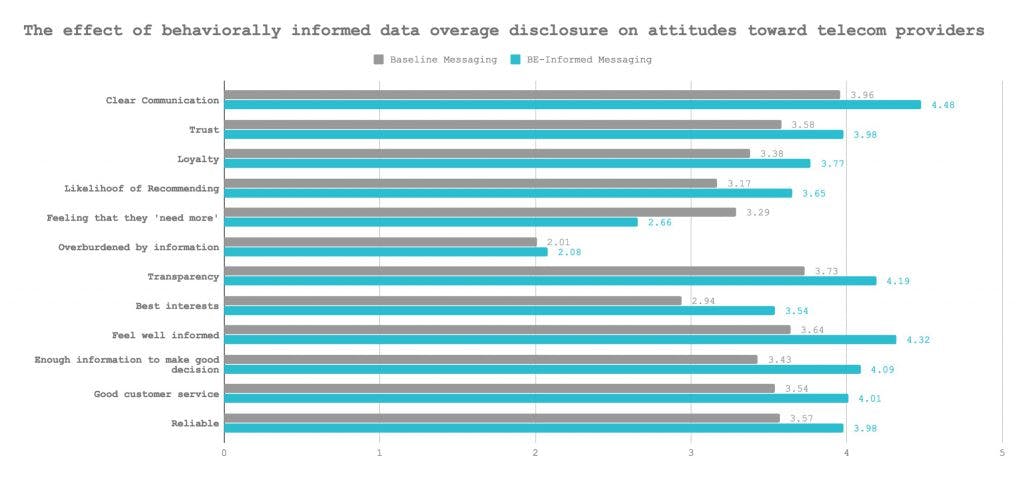Improving Data Overage Disclosure Practices
One of the major frustrations for consumers when interacting with companies is a lack of transparency in the fees they are paying for a service. This creates a sense of distrust and skepticism, where consumers feel like they are being “cheated” or “scammed” by big corporations. From a behavioral science perspective, understanding how trust is built and maintained is a critical point in the consumer journey to not only improve conversation rates but also customer retention.
From a consumer’s perspective, decreased trust lowers the perceived value of the company. If this perceived value is lower than the economic cost of the service, a loose-loose scenario is created for both the brand and the consumers. As a non-profit, The Decision Labs aims to leverage behavioral science in order to create win-wins between companies and consumers. We believe that both the consumer and the company can benefit from a better understanding of the product and the people that use them. Ultimately, those who succeed and continue to grow are those who leverage a deeper understanding of their consumer’s needs, biases and preferences and turn them into design opportunities. By guiding the design of customer interactions, the principles of behavioral science offer a simple, low-cost route to improved customer satisfaction and retention.
To illustrate this, we ran an online study that showed how improving data overage disclosure practices can improve consumers’ overall trust, loyalty and likelihood that they will recommend the provider. In 2017, Canadians spent about 1.3 Billion in overage fees according to the CRTC. Naturally, this creates frustration and friction that can, potentially, erode provider-client relationships by giving them a reason to distrust their providers. As a consumer, the cost of switching to another provider is low and the options are plenty. Therefore, optimizing for customer loyalty, especially at these friction points, is critical to customer retention.
Our sample size consisted of 104 Canadians (42% Female; 35% < 50,000 CAD household income; 18% Telus; 18% Rogers; 13% Bell Customers; 10% Koodo; 12% Fido; 8% Virgin; 2.8 years average time with current provider). We provided participants with a hypothetical month of text messages about data usage from a provider and asked them to rate the provider based on these interactions. We used a baseline message from a major Canadian provider and then created a series of messages based on behavioral economics concepts such as framing, salience, and social norms. For example, the standard warning message warned: “If you go over before then, your standard data rates will apply.” We attempted to convey that the provider has the consumer’s best interest in mind: instead of a warning, we advised “To avoid additional charges, learn how to manage data usage…” We found that these small changes in copy were able to have significant effects on consumer attitudes.

Behavioral Science, Democratized
We make 35,000 decisions each day, often in environments that aren’t conducive to making sound choices.
At TDL, we work with organizations in the public and private sectors—from new startups, to governments, to established players like the Gates Foundation—to debias decision-making and create better outcomes for everyone.
Chart 1
Specifically, this minor change in messaging increased trust by 11.3% (Chart 1) and feelings that the provider had their best interest in mind by 20.3%. We also found that this framing improved the perception of transparency, where 19% more participants felt like they had enough information to form a good decision about data overage. Critically, this messaging also demonstrated a 15.2% increase in the likelihood of recommending the service provider.
The AI Governance Challenge
Although we only implemented a simple tweak in the messaging, we were able to significantly change the way consumer’s perceived the trustworthiness, transparency and likability of the service provider. As a non-profit, our long term goal with studies in the telecommunications industry is to help providers convey information in a clear and positive way. By taking into consideration the behavioral and economic perspective, we can move towards a service/product design that optimizes for consumer-provider relationships in a way that is mutually beneficial for both parties.
About the Author
The Decision Lab
The Decision Lab is a Canadian think-tank dedicated to democratizing behavioral science through research and analysis. We apply behavioral science to create social good in the public and private sectors.





